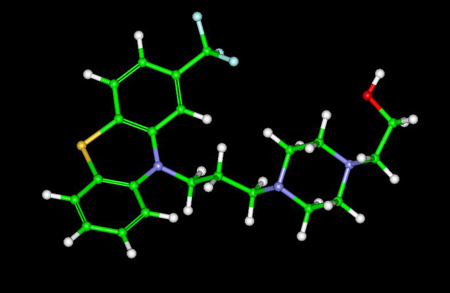Its main use is as a long acting injection given once every two or three weeks to people with schizophrenia who have a poor compliance with medication and suffer frequent relapses of illness. In some countries this can be involuntary under Community Treatment Orders. Its side effect profile is similar to haloperidol, namely predominantly dopamine-blocking effects which give rise to akathisia, parkinsonism and tremor. Long term side effects include the potentially irreversible tardive dyskinesia and the potentially fatal neuroleptic malignant syndrome.
Mechanism of Action: Fluphenazine blocks postsynaptic mesolimbic dopaminergic D1 and D2 receptors in the brain; depresses the release of hypothalamic and hypophyseal hormones and is believed to depress the reticular activating system thus affecting basal metabolism, body temperature, wakefulness, vasomotor tone, and emesis.Brand names
| Fluphenazine decanoate | Modecate, Prolixin Decanoate, Dapotum D, Anatensol, Fludecate, Sinqualone Deconoate |
| Fluphenazine enanthate | Dapotum Injektion, Flunanthate, Moditen Enanthate Injection, Sinqualone Enanthate |
| Fluphenazine hydrochloride | Prolixin, Permitil, Dapotum, Lyogen, Moditen, Omca, Sediten, Selecten, Sevinol, Sinqualone, Trancin |
Pharmacokinetics
Fluphenazine has an incomplete oral bioavailability of 40% to 50% (due to extensive first pass metabolization in the liver). Its half life is 15 to 30 hours.
Dosing
12.5 mg of fluphenazine decanoate is roughly equivalent to 100 mg of zuclopenthixol decanoate or 20 mg of flupentixol decanoate.
Side effects
Notable side effects include akathisia, extrapyramidal side effects, including tardive dyskinesia and Rabbit syndrome. The frequency and severity of extrapyramidal side effects are direct proportional to the dose given and the duration of treatment.
Sedative, allergic-toxic and anticholinergic/sympatholytic side effects are less likely to occur compared with chlorpromazine. The direct deposition of fluphenazine in the cornea and retina has so far not been reported.
Neuroleptic malignant syndrome, although rare, is a potentially lethal side effect of all antipsychotics.
References
- "Fluphenazine." Davis's Drug Guide for Nurses, Eighth Edition. F.A. Davis Company, 2005. ISBN 0-8036-2455-7
- FLUPHENAZINE DICHLORHYDRATE [Article in French] Biam Last Updated: 11 December 2000. Accessed 14 September 2005.

